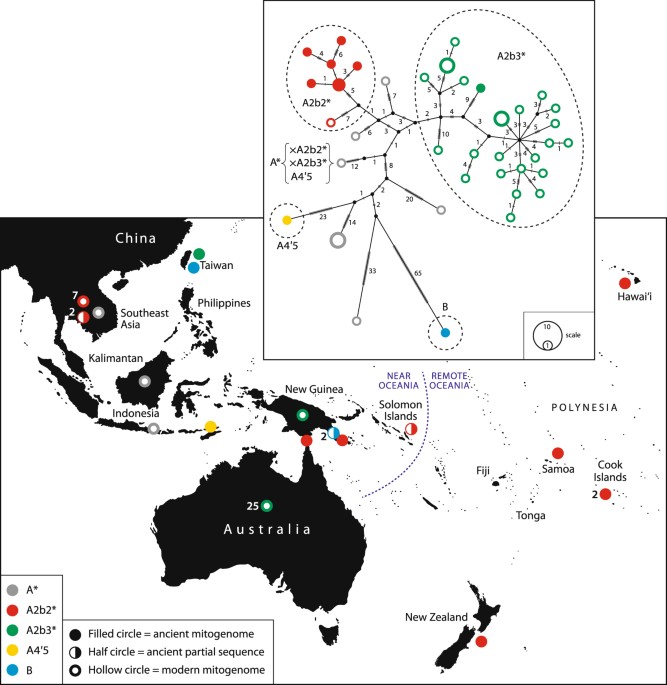Anderson, A. The rat and the octopus: initial human colonization and the prehistoric introduction of domestic animals to Remote Oceania. Biological Invasions 11, 1503–1519 (2009).
Google Scholar
Matisoo-Smith, E. In Genes, language and culture history in the Southwest Pacific (ed J S Friedlaender) 157–170 (Oxford University Press, 2007).
Bellwood, P. Holocene Population History in the Pacific Region as a Model for Worldwide Food Producer Dispersals. Current Anthropology 52, S363–S378 (2011).
Google Scholar
Kirch, P. V. On the road of the winds: an archaeological history of the Pacific Islands before European contact. (Univ of California Press, 2017).
Pang, J. F. et al. mtDNA Data Indicate a Single Origin for Dogs South of Yangtze River, Less Than 16,300 Years Ago, from Numerous Wolves. Molecular Biology and Evolution 26, 2849–2864, https://doi.org/10.1093/molbev/msp195 (2009).
Google Scholar
Savolainen, P., Zhang, Y.-P., Luo, J., Lundeberg, J. & Leitner, T. Genetic Evidence for an East Asian Origin of Domestic Dogs. Science 298, 1610–1613, https://doi.org/10.1126/science.1073906 (2002).
Google Scholar
Wang, G. D. et al. Out of southern East Asia: the natural history of domestic dogs across the world. Cell Res 26, 21–33, https://doi.org/10.1038/cr.2015.147 (2016).
Google Scholar
Savolainen, P., Leitner, T., Wilton, A. N., Matisoo-Smith, E. & Lundeberg, J. A detailed picture of the origin of the Australian dingo, obtained from the study of mitochondrial DNA. Proceedings of the National Academy of Sciences of the United States of America 101, 12387–12390, https://doi.org/10.1073/pnas.0401814101 (2004).
Google Scholar
Milham, P. & Thompson, P. Relative antiquity of human occupation and extinct fauna at Madura Cave, southeastern Western Australia. Mankind 10, 175–180 (1976).
Reponen, S. E. M., Brown, S. K., Barnett, B. D. & Sacks, B. N. Genetic and morphometric evidence on a Galápagos Island exposes founder effects and diversification in the first-known (truly) feral western dog population. Molecular Ecology 23, 269–283, https://doi.org/10.1111/mec.12595 (2013).
Google Scholar
Smith, B. P. & Litchfield, C. A. A Review of the Relationship between Indigenous Australians, Dingoes (Canis dingo) and Domestic Dogs (Canis familiaris). Anthrozoos: A Multidisciplinary Journal of The Interactions of People & Animals 22, 111–128, https://doi.org/10.2752/175303709X434149 (2009).
Google Scholar
Koler-Matznick, J., Yates, B. C., Bulmer, S. & Brisbin, I. L. J. The New Guinea singing dog: its status and scientific importance. Australian Mammalogy 29, 47–56, https://doi.org/10.1071/AM07005 (2007).
Google Scholar
Oskarsson, M. C. R. et al. Mitochondrial DNA data indicate an introduction through Mainland Southeast Asia for Australian dingoes and Polynesian domestic dogs. Proceedings of the Royal Society B: Biological Sciences 279, 967–974, https://doi.org/10.1098/rspb.2011.1395 (2012).
Google Scholar
Paijmans, J. L. A., Gilbert, M. T. P. & Hofreiter, M. Mitogenomic analyses from ancient DNA. Molecular Phylogenetics and Evolution 69, 404–416, https://doi.org/10.1016/j.ympev.2012.06.002 (2013).
Google Scholar
Horsburgh, K. A. et al. The Genetic Diversity of the Nguni Breed of African Cattle (Bos spp.): Complete Mitochondrial Genomes of Haplogroup T1. PLoS One 8, e71956, https://doi.org/10.1371/journal.pone.0071956 (2013).
Google Scholar
Lancioni, H. et al. Phylogenetic Relationships of Three Italian Merino-Derived Sheep Breeds Evaluated through a Complete Mitogenome Analysis. PLoS One 8, e73712, https://doi.org/10.1371/journal.pone.0073712.s006 (2013).
Google Scholar
Greig, K. et al. Complete Mitochondrial Genomes of New Zealand’s First Dogs. PLoS One 10, e0138536, https://doi.org/10.1371/journal.pone.0138536 (2015).
Google Scholar
Cairns, K. M. & Wilton, A. N. New insights on the history of canids in Oceania based on mitochondrial and nuclear data. Genetica 144, 553–565, https://doi.org/10.1007/s10709-016-9924-z (2016).
Google Scholar
Duleba, A., Skonieczna, K., Bogdanowicz, W., Malyarchuk, B. & Grzybowski, T. Complete mitochondrial genome database and standardized classification system for Canis lupus familiaris. Forensic Science International: Genetics 19, 123–129, https://doi.org/10.1016/j.fsigen.2015.06.014 (2015).
Google Scholar
Fregel, R. et al. Mitochondrial DNA haplogroup phylogeny of the dog: Proposal for a cladistic nomenclature. Mitochondrion. https://doi.org/10.1016/j.mito.2015.04.001 (2015).
Google Scholar
Bulmer, S. Settlement and economy in prehistoric Papua New Guinea: a review of the archeological evidence. Journal de la Société des Océanistes 31, 7–75 (1975).
Google Scholar
McNiven, I. J. et al. Midden formation and marine specialisation at Goemu village, Mabuyag, Torres Strait, before and after European contact. Memoirs of the Queensland Museum, Culture 8, 377 (2015).
Gibbs, M., Duncan, B. & Kiko, L. Spanish Maritime Exploration in the South‐west Pacific: the search for Mendaña’s lost almiranta, Santa Isabel, 1595. International Journal of Nautical Archaeology 44, 430–438 (2015).
Google Scholar
Addison, D. J. et al. Archaeology of Atafu, Tokelau: Some initial results from 2008. Rapa Nui Journal 23, 5–9 (2009).
Graves, M., Field, J. & McElroy, W. An overview of site 50-30-01-196, Nu ‘alolo Kai, Kaua ‘i: Features, excavation, stratigraphy, and chronology of historic and prehistoric occupation. Na Mea Kahiko o Kaua ‘i: Archaeological studies in Kaua ‘i. Special Publication, 149–187 (2005).
Greig, K., Boocock, J., Allen, M. S., Walter, R. & Matisoo-Smith, E. Ancient DNA evidence for the introduction and dispersal of dogs in New Zealand. Journal of Pacific Archaeology 9, 1–10 (2018).
Tsang, C. Recent advances in the Iron Age archaeology of Taiwan. Bulletin of the Indo-Pacific Prehistory Association 20, 153–158 (2000).
Kumar, S., Stecher, G. & Tamura, K. MEGA7: Molecular Evolutionary Genetics Analysis version 7.0 for bigger datasets. Molecular Biology and Evolution 33, 1870–1874 (2016).
Google Scholar
Gonzalez, A., Clark, G., O’Connor, S. & Matisoo-Smith, L. A 3000 year old dog burial in Timor-Leste. Australian Archaeology 76, 13–20 (2013).
Google Scholar
Cairns, K. M., Brown, S. K., Sacks, B. N. & Ballard, J. W. O. Conservation implications for dingoes from the maternal and paternal genome: Multiple populations, dog introgression, and demography. Ecology and Evolution 7, 9787–9807, https://doi.org/10.1002/ece3.3487 (2017).
Google Scholar
Cairns, K. Population differentiation in the dingo: biogeography and molecular ecology of the Australian Native Dog using maternal, paternal and autosomal genetic markers PhD thesis, University of New South Wales, (2014).
Sacks, B. N. et al. Y Chromosome Analysis of Dingoes and Southeast Asian Village Dogs Suggests a Neolithic Continental Expansion from Southeast Asia Followed by Multiple Austronesian Dispersals. Molecular Biology and Evolution 30, 1103–1118, https://doi.org/10.1093/molbev/mst027 (2013).
Google Scholar
Ardalan, A. et al. Narrow genetic basis for the Australian dingo confirmed through analysis of paternal ancestry. Genetica 140, 65–73, https://doi.org/10.1007/s10709-012-9658-5 (2012).
Google Scholar
Koler-Matznick, J., Brisbin, I. L., Feinstein, M. & Bulmer, S. An updated description of the New Guinea singing dog (Canis hallstromi, Troughton 1957). Journal of Zoology 261, 109–118, https://doi.org/10.1017/S0952836903004060 (2003).
Google Scholar
Dwyer, P. D. & Minnegal, M. Wild dogs and village dogs in New Guinea: were they different? Australian Mammalogy 38, 1–11 (2016).
Google Scholar
J. M. I. et al. Mask Cave: Red‐slipped pottery and the Australian‐Papuan settlement of Zenadh Kes (Torres Strait). Archaeology in Oceania 41, 49–81, https://doi.org/10.1002/j.1834-4453.2006.tb00610.x (2006).
Google Scholar
Balme, J. & O’Connor, S. Dingoes and Aboriginal social organization in Holocene Australia. Journal of Archaeological Science: Reports 7, 775–781, https://doi.org/10.1016/j.jasrep.2015.08.015 (2016).
Google Scholar
Spriggs, M. Archaeology and the Austronesian expansion: where are we now? Antiquity 85, 510–528 (2011).
Google Scholar
Piper, P. J. et al. Early Evidence for Pig and Dog Husbandry from the Neolithic Site of An Son, Southern Vietnam. International Journal of Osteoarchaeology 24, 68–78, https://doi.org/10.1002/oa.2226 (2014).
Google Scholar
Grant, A. & Higham, C. In The Excavation of Khok Phanom Di. Vol II The Biological Remains (Part I) Vol. 2 Research Report of the Society of Antiquaries of London (eds C. F. W. Higham & R. Bannanurag) 147–191 (1991).
Specht, J., Denham, T., Goff, J. & Terrell, J. E. Deconstructing the Lapita Cultural Complex in the Bismarck Archipelago. Journal of Archaeological Research 22, 89–140, https://doi.org/10.1007/s10814-013-9070-4 (2014).
Google Scholar
McNiven, I. J. et al. In Peopled Landscapes: Archaeological and Biogeographic Approaches to Landscapes (eds S. G. Haberle and B. David) 121–156 (Terra Australis, 2012).
Petchey, F. et al. 14C marine reservoir variability in herbivores and deposit-feeding gastropods from an open coastline, Papua New Guinea. Radiocarbon 54, 967–978 (2012).
Google Scholar
David, B. et al. A new ceramic assemblage from Caution Bay, south coast of mainland PNG: the linear shell edge-impressed tradition from Bogi 1. Journal of Pacific Archaeology 3, 73–89 (2012).
Kahn, J. G. & Sinoto, Y. Refining the Society Islands cultural sequence: Colonisation phase and developmental phase coastal occupation on Mo’orea Island. Journal of the Polynesian Society,
126, 33 (2017).
Google Scholar
Greig, K., Walter, R. & Matisoo-Smith, E. In The Routledge Handbook of Bioarchaeology in Southeast Asia and the Pacific Islands (eds M. Oxenham & H. Buckley) Ch. 21, 462–482 (Routledge, 2016).
Osmond, M. & Pawley, A. In The lexicon of Proto Oceanic: the culture and environment of ancestral Oceanic society, Volume 4: Animals (eds Malcolm Ross, Andrew Pawley, & Meredith Osmond) 217–269 (Pacific Linguistics, 2011).
Sutton, N., Summerhayes, G. & Ford, A. Regional Interaction Networks in Southern Papua New Guinea During the Late Holocene: Evidence from the Chemical Characterisation of Chert Artefacts. Proceedings of the Prehistoric Society, 1–17, https://doi.org/10.1017/ppr.2015.14 (2015).
Allen, J., Summerhayes, G., Mandui, H. & Leavesley, M. New Data from Oposisi: Implications for the Early Papuan Pottery Phase. Journal of Pacific Archaeology 2, 69–81 (2011).
Addison, D. J. & Matisoo-Smith, E. Rethinking Polynesians origins: A West-Polynesia Triple-I Model. Archaeology in Oceania 45, 1–12, https://doi.org/10.1002/j.1834-4453.2010.tb00072.x (2010).
Google Scholar
Larson, G. et al. Phylogeny and ancient DNA of Sus provides insights into neolithic expansion in Island Southeast Asia and Oceania. Proceedings of the National Academy of Sciences of the United States of America 104, 4834–4839, https://doi.org/10.1073/pnas.0607753104 (2007).
Google Scholar
Shannon, L. M. et al. Genetic structure in village dogs reveals a Central Asian domestication origin. Proceedings of the National Academy of Sciences 112, 13639–13644 (2015).
Google Scholar
Kircher, M. Analysis of high-throughput ancient DNA sequencing data. Methods in molecular biology (Clifton, NJ) 840, 197–228 (2012).
Google Scholar
Leigh, J. W. & Bryant, D. popart: full-feature software for haplotype network construction. Methods in Ecology and Evolution 6, 1110–1116, https://doi.org/10.1111/2041-210X.12410 (2015).
Google Scholar
Cock, P. J. A. et al. Biopython: freely available Python tools for computational molecular biology and bioinformatics. Bioinformatics 25, 1422–1423, https://doi.org/10.1093/Bioinformatics/Btp163 (2009).
Google Scholar
Posada, D. & Crandall, K. A. MODELTEST: testing the model of DNA substitution. Bioinformatics 14, 817–818 (1998).
Google Scholar
Drummond, A. J., Suchard, M. A., Xie, D. & Rambaut, A. Bayesian Phylogenetics with BEAUti and the BEAST 1.7. Molecular Biology and Evolution 29, 1969–1973, https://doi.org/10.1093/molbev/mss075 (2012).
Google Scholar
Katoh, K. & Standley, D. M. MAFFT Multiple Sequence Alignment Software Version 7: Improvements in Performance and Usability. Molecular Biology and Evolution 30, 772–780, https://doi.org/10.1093/molbev/mst010 (2013).
Google Scholar


